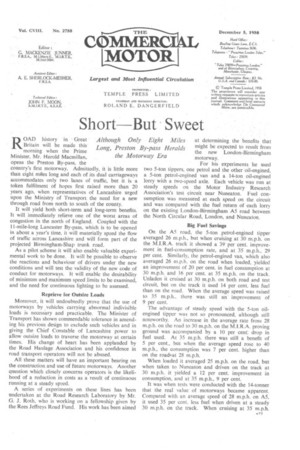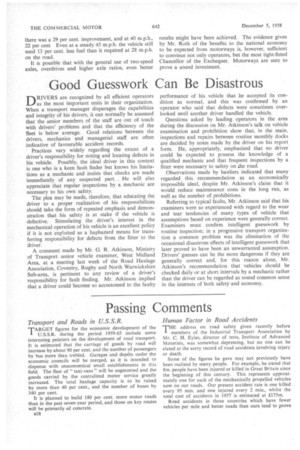Short But Sweet
Page 33

Page 34

If you've noticed an error in this article please click here to report it so we can fix it.
ROAD history in Great Britain will be made this morning when the Prime Minister, Mr. Harold Macmillan, opens the Preston By-pass, the country's first motorway. Admittedly, it is little more than eight raiies long and each of its dual carriageways accommodates only two lanes of traffic, but it is a token fulfilment of hopes first raised more than 20 years ago, when representatives of Lancashire urged upon the Ministry of Transport the need for a new through road from north to south of the county.
It will yield both short-term and long-term benefits. It will immediately relieve one of the worst areas of congestion in the north of England. Coupled with the 11-mile-long Lancaster By-pass, which is to be opened in about a year's time, it will materially speed the flow of traffic across Lancashire and will form part of the projected Birmingham-Shap trunk road.
As a pilot scheme it will also enable valuable experimental work to be done. It will be possible to observe the reactions and behaviour of drivers under the new conditions and will test the validity of the new code of conduct for motorways. It will enable the desirability of minimum and maximum speed limits to be examined, and the need for continuous lighting to be assessed.
Reprieve for Outsize Loads Moreover, it will undoubtedly prove that the use of motorways by .vehicles carrying abnormal indivisible loads is necessary and practicable, The Minister of Transport has shown commendable tolerance in amending his previous design to exclude such vehicles and in giving the Chief Constable of Lancashire power to allow outsize loads to traverse the motorway at certain times. His change of heart has been applauded by the Road Haulage Association and his confidence in road transport operators will not be abused.
All these matters will have an important bearing on the construction and use of future motorways. Another question which closely concerns operators is the likelihood of a reduction in costs as a result of continuous running at a steady speed.
A series of experiments on these lines has been undertaken at the Road Research Laboratory by Mr. G. J. Roth, who is working on a fellowship given by the Rees Jeffreys Road Fund. His work has been aimed at determining the benefits that might be expected to result from the new London-Birmingham motorway.
For his experiments he used two 5-ton tippers, one petrol and the other 'oil-engined, a 5-ton petrol-engined van and a 14-ton oil-engined lorry with a two-speed axle. Each vehicle was run at steady speeds on the Motor Industry Research Association's test circuit near Nuneaton. Fuel consumption was measured at each speed on the circuit and was compared with the fuel return of each lorry on the existing London-Birmingham A5 road between the North Circular Road, London, and Nuneaton.
Big Fuel Savings On the A5 road, the 5-ton petrol-engined tipper averaged 26 m.p.h., but when cruising at 30 m.p.h. on the M.I.R.A. track it showed a 39 per cent. improvement in fuel-consumption rate, and at 35 m.p.h., 29 per cent. Similarly, the petrol-engined van, which also averaged 26 m.p.h. on the road when loaded, yielded an improvement of 20 per cent. in fuel consumption at 30 m.p.h. and 16 per cent. at 35 m.p.h. on the track. Unladen it cruised at 30 m.p.h. on both road and test circuit, but on the track it used 14 per cent, less fuel than on the road. When the average speed was raised to 35 m.p.h., there was still an improvement of 9 per cent.
The advantage of steady speed with the 5-ton oilengined tipper WaS not so pronounced, although still noteworthy. An increase in the average rate froni 28 mph. on the road to 30 m.p.h, on the M.I.R.A. proving ground was accompanied by a 10 per cent: drop in fuel used. At 35 m.p.h. there was still a benefit of 5 per cent., but when the average speed rose to 40 m.p.h., the consumption was 7 per cent. higher than on the roadeat 28 m.p.h.
When loaded it averaged 25 m.p.h. on the road, but when taken to Nuneaton and driven on the track at 30 m.p.h. it yielded a 12 per cent. improvement in consumption, and at 35 m.p.h., 9 per cent.
It was when tests were conducted with the 14-tonner that the real value of motorways became apparent. Compared with an average speed of 28 m.p.h. on A5, it used 35 per cent. less fuel when driven at a steady 30 m.p.h. on the track. When cruising at 35 m.p.h. there was a 29 per cent. improvement, and at 40 m.p.h., 22 per cent Even at a steady 45 m.p.h. the vehicle still used 13 per cent. less fuel than it required at 28 m.p.h. on the road.
It is possible that with the general use of two-speed axles, overdrives and higher axle ratios, even better results might have been achieved. The evidence given by Mr. Roth of the benefits to the national economy to be expected from motorways is, however, sufficient to convince not only operators, but the most tight-fisted Chancellor of the Exchequer. Motorways are sure to prove a sound investment.
























































































































